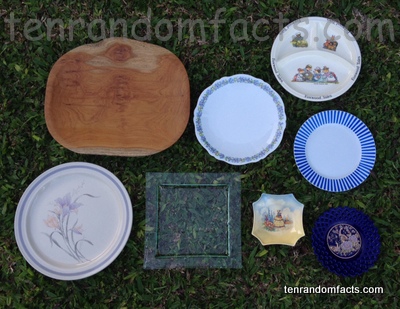Have a plate for your bread and a plate for your roast.
- Plates are an invention used to serve food in both a household and a commercial setting, both to increase presentation but also for practical purposes.
- Plates are generally quite flat with a slight bowl or dip spreading from the centre, which is where food is generally served.
- The three main sections that make up a plate are the rim, which is the outermost edge; the base, the underneath surface where the dishware rests; and the well, where the food is placed.
- A variety of materials can be used to make plates including ceramics, metal, glass, cardboard, wood and plastic, while cardboard is generally used for those that are used once only and disposed of, and some plastic ones are also made with this purpose in mind.
- Plates come in a wide variety of sizes, generally ranging from 10 to 36 centimetres (4 to 14 inches) in diameter, and the most common are usually between 25.5 to 30.5 centimetres (10 to 12 inches); and the size generally determines its use.
- Early plates were likely natural items such as large shells or big leaves, and old bread was also utilised, while wood, pewter, silver and clay items were later employed for this purpose, however they were designed for communal use, rather than as individual pieces.
- Stereotypically, plates are of a round shape, although some cultures prefer a rectangular or ellipse shape, and square ones are not uncommon.
- The Chinese created plates from porcelain through the ceramic process in the 7th century, and these were made available to Europeans from the 1300s, although it was not until the 1700s that Europeans started making the products themselves.
- Some people collect plates as a hobby, although they are usually used to hold a wide variety of food, including main meals, entrees, buffets and bread; while a small one designed to hold a cup is known as a ‘saucer’.
- In European countries, porcelain plates were originally reserved for those of wealthy status due to their expense and limited availability due to the product being made in China, however, they became affordable and readily available in the 1800s due to more efficient manufacturing processes.






Here’s a good TRF subject. Moonlighter plant Dendrocnide Moroides seen at Airlie Beach